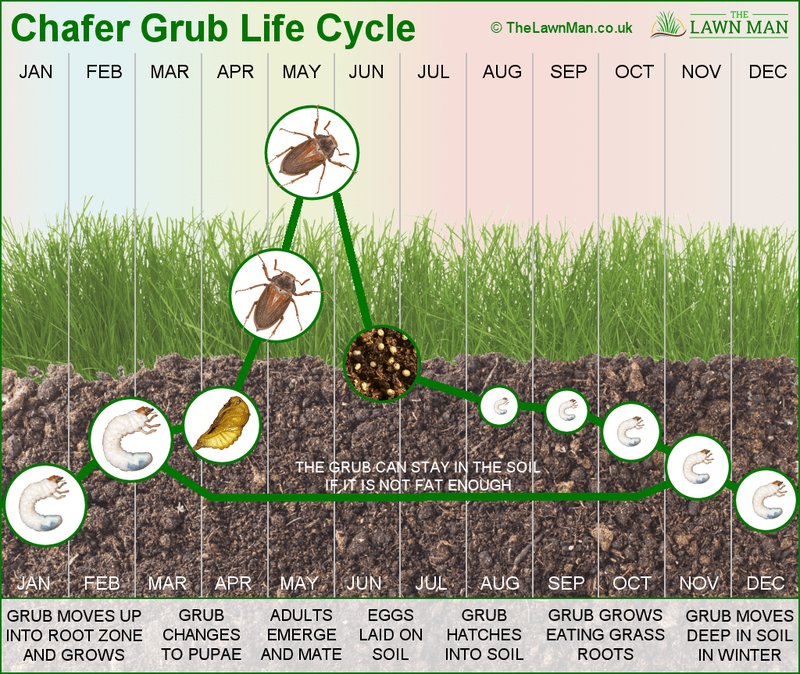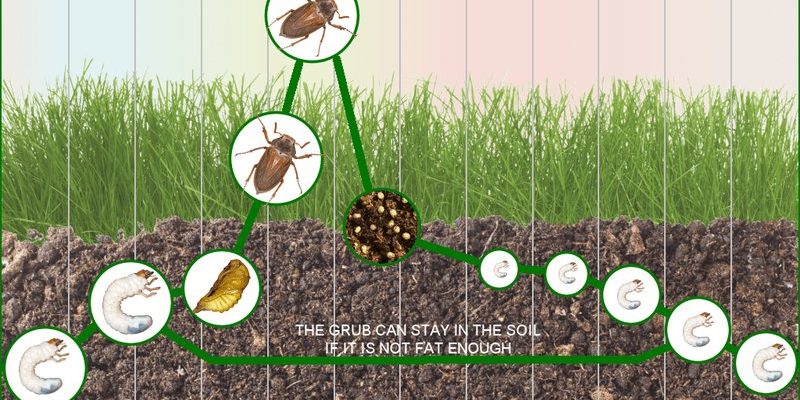
Let’s think about it like this: Imagine you’re following a friend through their day-to-day life. You wouldn’t just want to know what they do at work; you’d want to understand their morning routine, their lunch break, and how they unwind in the evening. The same goes for the lifecycle of the masked chafer grub. It’s not just about the adult beetle you might see flying around; it’s about all the steps it takes to get there.
What Are Masked Chafer Grubs?
Masked chafer grubs, or *Cyclocephala* larvae, are the larval stage of a beetle that belongs to the Scarabaeidae family. They are typically found in lawns and gardens where they feed on the roots of grasses and other plants. These grubs are usually creamy white, with a C-shaped body and a brown head.
As they mature, you might notice them causing patches of grass to die off, which can be a nuisance for homeowners. They thrive in moist environments and are often found in sandy soils. Understanding where and how these grubs develop can help you manage them effectively if needed.
The Egg Stage
The lifecycle of the masked chafer grub starts in early summer. Adult female beetles lay their eggs in the soil. These tiny eggs are almost invisible, about the size of a pinhead. A single female can lay around 30 to 60 eggs at a time!
Here’s where it gets interesting: the eggs are vulnerable to various environmental factors. If it’s too dry or too cold, they might not hatch. However, in the right conditions, usually within two to three weeks, the eggs hatch, giving way to the grubs.
The Grub Stage
Once the eggs hatch, the tiny grubs begin their lives right below the soil. This stage can last for several months, usually from late summer to early fall. During this time, they have a voracious appetite, feeding on organic matter and the roots of nearby plants.
You might be wondering, how do they actually feed? Well, these little guys use their strong mandibles to munch on the roots, often causing significant damage to your lawn or garden. However, they aren’t just pests; their feeding can help aerate the soil, which is a little silver lining!
How to Spot Grubs
If you think you might have a grub problem, look for these signs:
- Patches of dead grass that peel back easily
- Birds or animals digging up your lawn
- Visible grubs when you dig a little
Don’t worry if you find some grubs; they’re part of nature’s cycle. But if their numbers are high, it might be time to take action.
The Pupal Stage
As the weather starts to cool down, the grubs prepare for their transformation. They enter the pupal stage, where they stay in the soil, wrapped in a protective casing. This stage can last for several weeks, generally throughout the fall and into winter.
The fascinating part? Inside this cocoon, their bodies are changing drastically. All the feeding and growing they did as grubs is getting them ready for their next big leap into adulthood. It’s like a caterpillar turning into a butterfly, but instead, we’re talking about beetles!
The Adult Beetle Stage
When spring arrives, the cycle comes full circle. The adult masked chafer beetles emerge from the soil, ready to start the process all over again. They’re usually brown or black, with distinctive markings that give them their “masked” name.
These beetles are most active in the warm months, often flying at night. It’s fascinating to think about how they journey from tiny eggs to flying adults, all while playing roles in the ecosystem, like pollination and decomposition.
Why They Matter
While they can be a nuisance for gardeners, masked chafer grubs and their adult counterparts play a crucial role in maintaining healthy soil. They help break down organic matter, making nutrients available for plants. So, when managing them, it’s essential to balance control measures with respect for their part in nature.
Managing Masked Chafer Grubs
If you find yourself with a grub problem, don’t panic! There are ways to manage their population without completely disrupting your garden.
Here are some effective strategies:
- Encourage natural predators like birds or beneficial nematodes.
- Use organic treatments, like milky spore disease, to target grubs while being gentle on the environment.
- Maintain healthy lawn care practices to prevent infestations.
Sometimes, a healthy lawn is the best defense against unwanted pests. Regular mowing, watering, and fertilization go a long way in keeping your grass robust and less appealing to grubs.
Understanding the lifecycle of masked chafer grubs helps us appreciate their place in our ecosystem. From their tiny beginnings as eggs to their roles as adult beetles, these creatures contribute more than we might realize. While they can sometimes cause trouble in our gardens, knowing how to manage them effectively can lead to a harmonious balance in nature.
So, next time you spot a grub in your yard, remember—it’s not just a pest; it’s part of a fascinating life story that connects to the broader web of life around us. Embrace the cycle and let the masked chafer grubs remind you of the wonders of nature!

